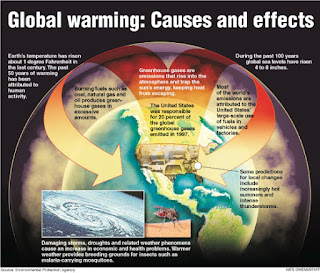The Earth's atmosphere contains gases that trap heat near the Earth's surface. These ‘greenhouse gases’ are necessary to sustain life on Earth. They let the sun’s rays enter but stop some heat from escaping to outer-space. This keeps the planet warm enough to allow life to thrive.
As people cause more greenhouse gases to be released into the atmosphere, the greenhouse effect becomes stronger. More heat is trapped and the Earth's climate begins to change unnaturally.
Greenhouse gases include water vapour, carbon dioxide and other gases like methane and nitrous oxide.
Causes of the greenhouse effect
Burning fossil fuels is changing the amount of greenhouse gases in the atmosphere in three important ways.
Deforestation produces 18 per cent of global carbon dioxide
Burning fossil fuels
When fossil fuels like coal, oil and gas are burned, they release greenhouse gases. In 2005, burning fossil fuels sent about 27 billion tonnes of carbon dioxide into the atmosphere.
People burn fossil fuels to create energy, which is used for many things including:
· Heating homes and buildings
· Growing, transporting and cooking food
· Travelling (for example, by car, plane, bus and train)
· Treating water to make it drinkable, heating it and piping it into homes
· Manufacturing, using and transporting products, from clothes to fridges, from plastic bags to batteries
Deforestation
Cutting down forests faster than they are replaced (deforestation) is a major contributor to climate change. It accounts for about 20 per cent of human carbon emissions – more than the entire global transport sector produces.
Deforestation makes such a huge contribution to carbon emissions because trees absorb carbon dioxide as they grow. The more trees that are cut down, the fewer there will be left to absorb carbon dioxide, leading to it building up in the atmosphere.
In addition, the agriculture and industry that replace the forests often cause an extra problem by producing carbon emissions of their own.
Carbon dioxide is the most important greenhouse gas after water vapour and contributes strongly to the greenhouse effect. Since the Industrial Revolution, which began in the 18th century, the amount of carbon dioxide in the atmosphere has increased by about 40 per cent. The concentration of carbon dioxide in the Earth's atmosphere is now higher than at any time in at least the last 800,000 years


